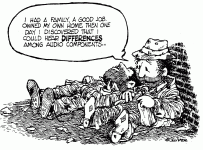Some forum members think, after many years of practical work with HiFi, audio electronics, that e.g. designs of e.g. electrical parts (transistors, valves, resistors...) have an influence on the sound.
Outside of the discussion about the methods of the collection and evaluation of sound differences, I want to link a short film clip, which could - or can/does;-? - explain the influence physically:
Outside of the discussion about the methods of the collection and evaluation of sound differences, I want to link a short film clip, which could - or can/does;-? - explain the influence physically:
Sound forms After leaving speaker's membrane, and this not true even( ...ever) because sound happens(=becomes such) in the brain.
The form of the membrane determines directivity, like more concave woofers in the midrange. A Dome tweeter might show phase problems between the apex and the base of the dome, that's the reason of some 'forms'(phase plugs) in front of it.
Have I've been too pedantic?!
The form of the membrane determines directivity, like more concave woofers in the midrange. A Dome tweeter might show phase problems between the apex and the base of the dome, that's the reason of some 'forms'(phase plugs) in front of it.
Have I've been too pedantic?!
Musical sound differentiate from others soundbecause sound happens(=becomes such) in the brain.
Re: "Forgotten Scientist Who Dare To See Electric"
Charles Edward Rose Bruce, M.A., BSc. extended the physics in his 1941 paper "The Lightning Discharge" towards explaining cosmological phenomena:
https://prabook.com/web/charles.bruce/2496263
His electrical models of the Sun, novae, nebulae and galaxies are based on electrical discharges in plasma, and have little direct relevance to everyday audio.
The closest audio association with Bruce's work would be the plasma tweeter: https://www.lansche-audio.com/products/plasmatweeter/
Charles Edward Rose Bruce, M.A., BSc. extended the physics in his 1941 paper "The Lightning Discharge" towards explaining cosmological phenomena:
https://prabook.com/web/charles.bruce/2496263
His electrical models of the Sun, novae, nebulae and galaxies are based on electrical discharges in plasma, and have little direct relevance to everyday audio.
The closest audio association with Bruce's work would be the plasma tweeter: https://www.lansche-audio.com/products/plasmatweeter/
Last edited:
Have I've been too pedantic?!
Perhaps in the sense that your comments do not refer to the content of the video, pico! 🙂
The Electric Universe explains why Mundorf capacitors sound so good.
Or not.
Or not.
The Magnetic Universe explains how Flux capacitor works @ 88mph.The Electric Universe explains why Mundorf capacitors ...
Your video refers to cosmological phenomena, for which 'size parsec' would be more applicable.
And in space we can hear HEE HAW (Scottish term for nothing). 😀
And in space we can hear HEE HAW (Scottish term for nothing). 😀
;-)
"Space" is not a physical and not a cosmic phenomenon;-)
Just a conceptual;-) At best a supposed-("cosmo")-logical;-)
"Space" is not a physical and not a cosmic phenomenon;-)
Just a conceptual;-) At best a supposed-("cosmo")-logical;-)
- Home
- Member Areas
- The Lounge
- Components-forms do affect signal, sound? A response offer:
